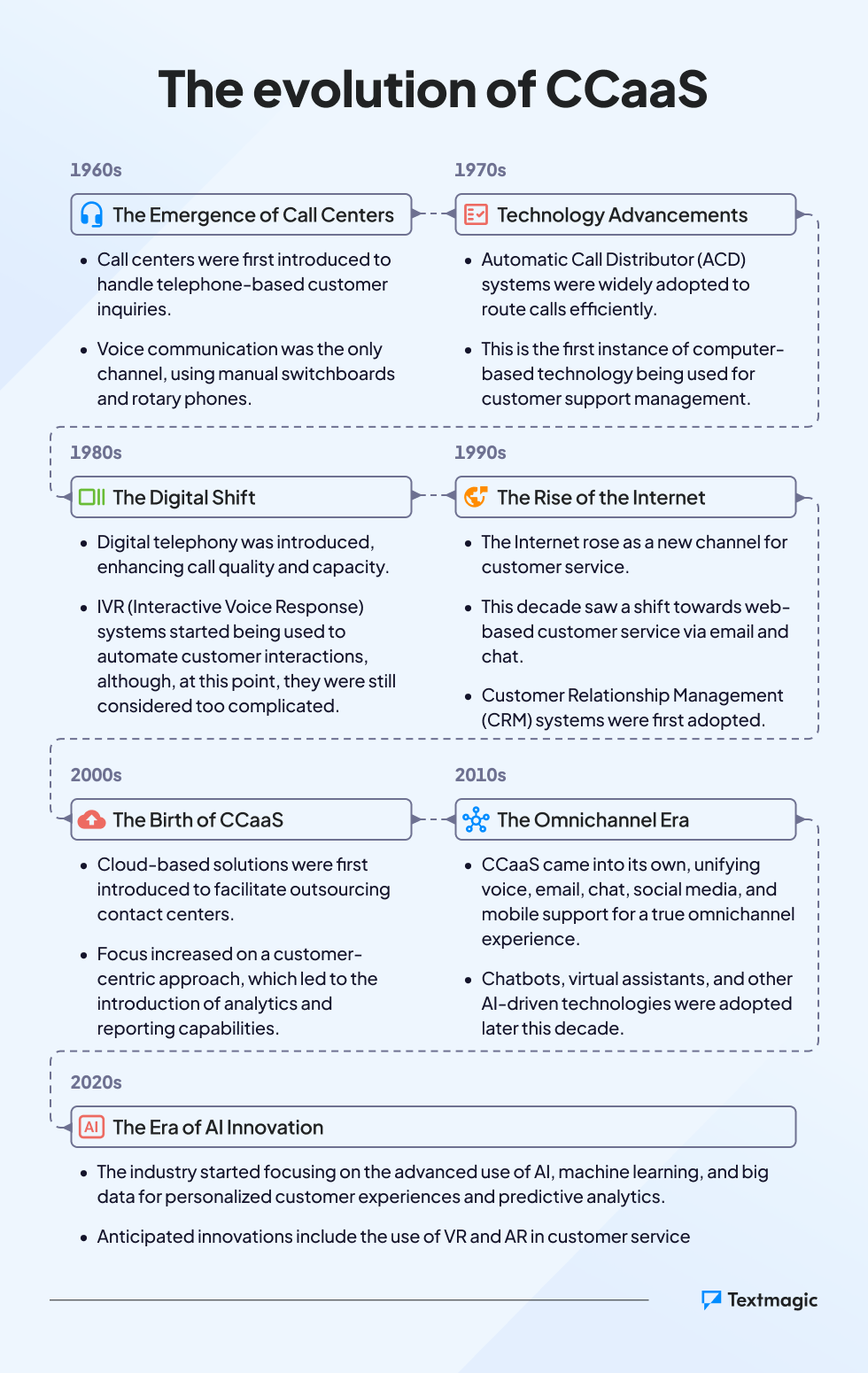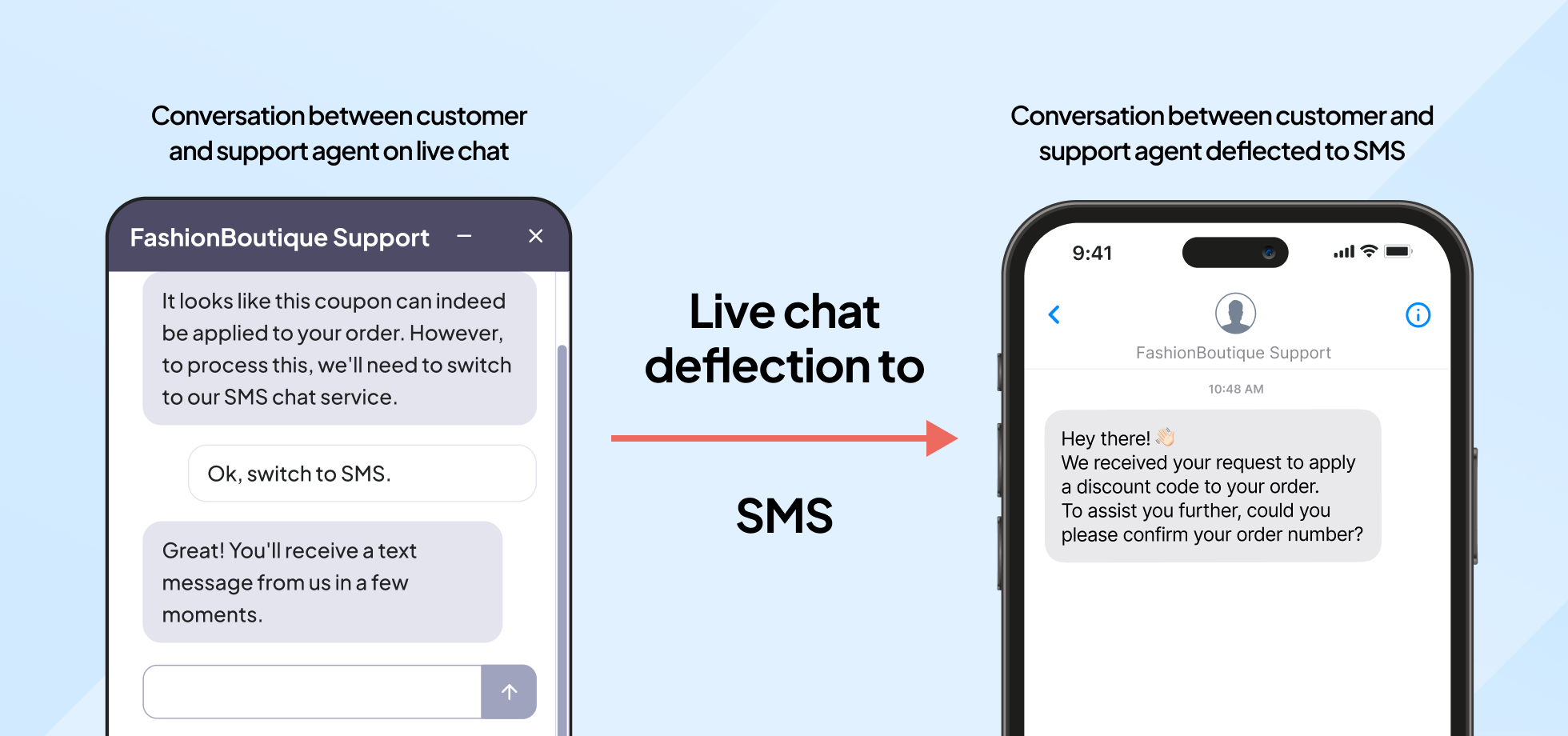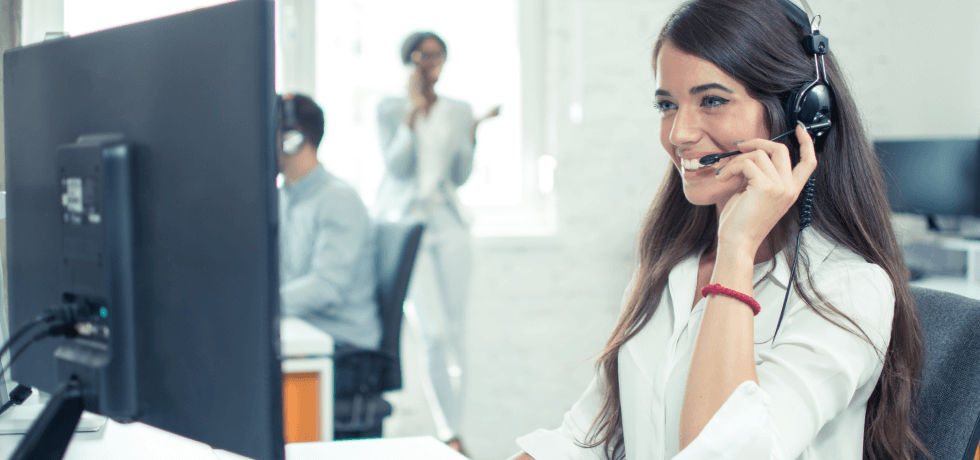
The evolution of contact centers towards cloud-based solutions marks a significant shift in how businesses manage customer interactions. Traditional, on-premise contact centers have evolved into Contact Center as a Service (CCaaS), offering enhanced flexibility, scalability, and the ability to integrate with various digital communication channels.
This transition underscores a commitment to offer seamless omnichannel support by leveraging the latest in cloud technology to meet the modern consumer’s expectations. Let’s cover the meaning of CCaaS and what sets the model apart from call centers and on-premise contact centers.
What is CCaaS?
CCaaS (Contact Center-as-a-Service) is a cloud-based software model that provides businesses with comprehensive customer communication tools, thus eliminating the need for a traditional in-house call center infrastructure. It’s usually delivered on a subscription basis.
The main purpose of CCaaS is to integrate various customer touchpoints into a unified platform. This includes phone calls, website chats, emails, support tickets, and text messages.
Its cloud infrastructure is what primarily sets CCaaS apart from traditional contact center models. This scalable and flexible approach to customer interactions allows businesses to adjust their resources based on demand without restructuring their internal IT departments or moving physical call center equipment around.
CCaaS is also considerably less capital-intensive than traditional contact centers, as it doesn’t require a large initial investment to set up. The technology behind it has come a long way since the first telephone-based call centers emerged in the 1960s, as illustrated below.

Key features of CCaaS
CCaaS solutions come with a series of features that can increase the effectiveness of a company’s customer service operations. Here’s an overview:
- Automatic contact distributor (ACD) – a system that routes incoming calls to available support agents based on factors such as department, skill set, or customer priority.
- Interactive voice response (IVR) – an automated system that interacts with callers through voice or key inputs, allowing customers to navigate menus, access information, or be routed to a support agent.
- Predictive dialer – a tool that automates outbound calls, predicting the best time to call a customer in order to increase contact rates.
- Digital deflection – a feature that transfers customer inquiries from one support channel to another (i.e. from live chat to text messaging, as illustrated in the image below).

- CRM integration – a capability enabling agents to access customer data and history across all channels and achieve personalized customer interactions.
- Workforce management (WFM) – a set of tools that cover areas such as forecasting call volumes, scheduling staff appropriately, and tracking agent performance.
- Multi-channel communication – various communication channels that allow customers to interact with a company, such as voice, email, text, web chat, and social media integrations.

- Quality management – a set of features that ensure consistent support quality, such as tracking and evaluating agent performance, live monitoring, and feedback collection.
- Self-serve capabilities – automated services, such as knowledge bases, AI assistants, or self-service portals, allowing customers to solve their own inquiries.
- Unified reporting – a comprehensive view of customer interactions and agent performance across all channels.
On-premise vs. cloud contact center: Which one is better?
Choosing between an on-premise contact center and a cloud contact center is a complex process that depends on your business needs, budget, and strategic direction.
On-premise contact centers are physically located within a company’s premises. This grants complete control over their infrastructure, as well as other aspects such as data security and setup customization.
This model suits organizations prioritizing data control and those with the resources to invest in hardware, software, and ongoing maintenance. However, it requires a significant upfront investment and a dedicated IT team to manage its setup and management.
Cloud contact centers are hosted on a service provider’s servers and accessed over the Internet. This model offers flexibility, scalability, and cost efficiency, being ideal for businesses looking for quick deployment.
A cloud-hosted operations base is also suitable for companies that want to scale up or down freely without requiring huge investments or alterations in physical equipment. Still, the approach raises some potential concerns over data security, as it comes with less centralized control over the entire infrastructure.
In short, each mode has its own advantages and limitations. For more clarity, we’ve illustrated them in the table below.
| Feature | On-premise contact center | Cloud contact center |
|---|---|---|
| Data security | Total control over data, facilitating compliance efforts | Depends on the provider, which stresses the need for a proper selection process |
| Remote access | Can be limited or require additional setup | Inherently supports remote access, facilitating flexible work arrangements |
| Company type | Larger organizations with specific compliance needs | SMEs valuing flexibility, scalability, and cost-efficiency |
| Control | High control over infrastructure and data security | Less control over infrastructure but provides flexibility and ease of update |
| Cost | Requires significant upfront investment | Lower initial costs with a pay-per-use pricing model |
| Maintenance | Needs in-house IT expertise for ongoing maintenance | Reduced need for in-house IT staff due to provider-managed maintenance |
| Scalability | Less flexible, adjustments to capacity can be slow and costly | Highly scalable and flexible, easy to adjust resources quickly |
| Deployment | Longer deployment times due to physical infrastructure setup | Quick deployment and easy access to the latest features and integrations |
Call center vs contact center: What’s the difference?
A call center is a centralized hub for receiving or making large volumes of requests by phone. Its primary focus is on voice communication, handling both inbound and outbound calls. Call centers are traditionally used for telemarketing, customer support, and other similar services.
A contact center is the evolution of the call center model. It’s designed to handle customer interactions across multiple channels beyond just voice calls, providing a unified customer experience. This includes email, text messaging, web chat, social media, and sometimes video communication.
The key difference lies in the scope of communication – call centers focus on voice calls, while contact centers offer a multi-channel approach to customer engagement. You can find a more detailed exploration in the table below.
| Feature | Call center | Contact center |
|---|---|---|
| Primary focus | Voice calls | Multiple communication channels |
| Channels | Phone only | Phone, email, text messaging, web chat, social media, and video |
| Purpose | Handling high volumes of inbound and outbound calls | Providing a unified customer experience across various channels |
| Engagement level | Low to moderate (limited to voice communication) | High (personalized and efficient service across multiple platforms) |
| Adaptability | Low (primarily fixed to voice communication needs) | Very high (adapts to changing communication preferences) |
| Analytics | Limited (metrics such as call volume, duration, wait time) | Comprehensive (covering all forms of customer interactions) |
Benefits of CCaaS for businesses
CCaaS is pivotal in modernizing business operations and enhancing customer engagement strategies. Here are the benefits of using it:
- Unified customer interactions. CCaaS consolidates all forms of customer communication (calls, emails, chats, social media, etc.) into a single platform.
- Cost efficiency. Businesses can significantly reduce upfront hardware investments and operational expenses by leveraging cloud technology.
- Enhanced customer experience. CCaaS enables efficient, personalized interactions across all channels, improving customer retention and loyalty.
- Operational agility. The flexibility of CCaaS allows businesses to scale operations swiftly up or down based on demand.
- Business continuity. With cloud-based infrastructure, CCaaS ensures that customer service operations persist despite external disruptions.
- Access to innovative features. Subscribing to a CCaaS model provides businesses continuous access to the latest AI-driven and automation features.
How to implement CCaaS in your organization
Equipping your organization with a strong CCaaS platform can significantly enhance your customer service operations. Here’s a step-by-step guide to help you make the transition:
1. Assess your business needs
What are your current customer service capabilities? Where do you need to improve your approach? Consider call volumes, preferred customer interaction channels, integration needs, and other case-by-case features your business could benefit from.
2. Choose your CCaaS provider
After outlining your company’s needs, it’s time to look at CCaaS providers. Aspects such as reliability, scalability, security measures, and cost should be crucial in your decision-making process. For a more detailed outlook on this topic, check out the next section of this article.
3. Plan the integration
Once you’ve selected a provider, plan how the CCaaS solution will integrate with your existing infrastructure. This includes CRM systems, databases, and other software, so make sure you work closely with your provider to understand technical requirements and limitations.
4. Implement the solution
With a plan in place, begin the implementation process. This might involve installing new hardware, configuring software, and integrating systems. Ensure that the CCaaS platform is customized to meet your business’s unique needs.
5. Train your team
Before going live, ensure your customer support agents know the product. Use hands-on sessions, tutorials, and technical materials to demonstrate how to use the new system and make the most out of the new channels of engagement they will have.
6. Launch the project
After planning, testing, and training, you can go live with the CCaaS platform. If possible, start with a phased approach. This will allow you to manage the transition more smoothly and adjust as needed.
7. Optimize post-deployment
Post-launch, continuously monitor the system’s performance and gather staff and customer feedback. Use this information to identify any issues or areas for improvement, then address them as you see fit.

How to choose the right CCaaS provider
Selecting the right CCaaS platform is crucial when you aim to deliver exceptional customer service across the board. Here are the key factors to consider:
- A proven track record of high uptime and reliability
- Extensive feature set that suits your business needs
- Scalable solutions that can grow alongside your company
- Robust customer support and clear SLAs
- Compliance with relevant industry standards and regulations
- Strong data security and privacy protections
- A pricing model that aligns with your budget
Choose from the top CCaaS providers on the market while keeping each of their capabilities in mind.
- Genesys is known for its comprehensive feature set and strong AI capabilities, offering solutions for businesses of all sizes. The platform on personalization and customer engagement.
- NICE offers a robust cloud contact center platform with extensive omnichannel support, strong analytics, and workforce optimization tools catering to various industries.
- Five9 stands out through its user-friendly interface and extensive integration options. The CPaaS provider offers a scalable solution with advanced AI features fit for improving customer interactions and agent productivity.
- Talkdesk is easy to use, has innovative features, and strongly emphasizes customer experience analytics. It’s ideal for companies focusing on customer insights and satisfaction.
- Avaya offers a flexible and highly customizable platform that integrates with various third-party applications. It’s most suitable for businesses looking for a tailored solution.
Conclusion
The industry shift towards CCaaS solutions is a significant advancement in how businesses manage customer interactions. By prioritizing flexibility and scalability, the model offers a comprehensive approach that addresses the evolving demands of customer service.
In conclusion, embracing CCaaS enhances customer satisfaction and improves operational efficiency. Thus, it’s an essential strategy for businesses looking to thrive in today’s competitive landscape.
Frequently Asked Questions (FAQs)
Unlike on‑premise systems tied to hardware, CCaaS is fully cloud-based.
This enables you to manage phone, email, chat, SMS, and social media interactions from any device, scaling dynamically as needed.
CCaaS delivers flexibility, operational cost savings, and unified customer communication.
It supports omnichannel routing and reporting, helping you deliver faster, more consistent support.
Look for AI-powered automation (like chatbots), analytics dashboards, omnichannel routing, workforce management, and real-time sentiment analysis. These tools elevate efficiency and customer experience.
Most modern CCaaS solutions include advanced encryption, strict access controls, and audit-ready monitoring to support regulations like GDPR and CCPA. This way, data security becomes a built-in advantage.
Related articles
How to run your Black Friday Email & SMS campaigns with Textmagic
Black Friday doesn’t have to be chaos. This guide sh...
A guide to WhatsApp customer service with Textmagic
Using WhatsApp for customer service with Textmagic a...
What is SMS OTP (One-Time Passcode) verification?
Learn how SMS OTP works and why it's become a crucia...
Textline vs. Textmagic: Feature comparison and key differences
Choosing the right business messaging platform can s...
6 Strategic communication plan templates for your team
Have you ever wondered how to ensure everyone in you...




